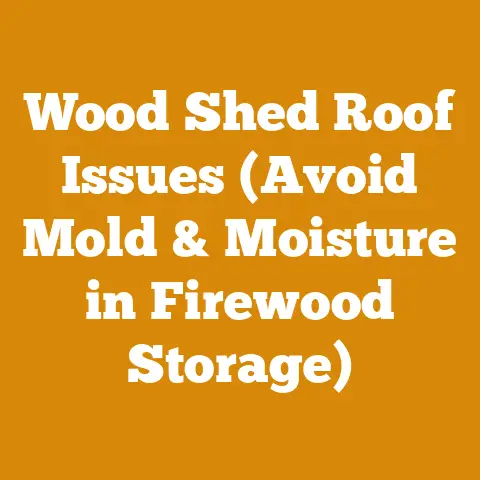Doug Fir Siding Durability (5 Expert Tips for Untreated Posts)
I remember visiting a friend, a true trendsetter in sustainable living, who had chosen Doug Fir for his home’s siding.
He wasn’t just after the aesthetic appeal; he was making a statement about durability and natural beauty.
He told me, “I want something that ages gracefully, like a fine wine.” That conversation sparked my deep dive into understanding the real-world performance of Doug Fir siding, particularly when left untreated.
Key Takeaways:
- Untreated Doug Fir can last a surprisingly long time with proper design and maintenance.
- Understanding wood properties and decay factors is crucial for longevity.
- Simple, effective strategies can significantly extend the life of your Doug Fir siding.
- Choosing the right cuts and grades makes a world of difference.
- Regular inspection and timely repairs are essential for long-term performance.
Let’s explore how to maximize the lifespan of untreated Doug Fir siding.
Doug Fir Siding Durability: 5 Expert Tips for Untreated Posts
Understanding Doug Fir: More Than Just a Pretty Face
Doug Fir (Pseudotsuga menziesii) is a softwood species prized for its strength, workability, and distinctive grain pattern.
It’s a common choice for construction, furniture, and, of course, siding.
But here’s the catch: Doug Fir is moderately resistant to decay.
This means that while it’s not as naturally rot-resistant as cedar or redwood, it can still perform admirably if you understand its limitations and take appropriate precautions.
The Science Behind the Wood:
- Density: Doug Fir has a density of around 34 lbs/cubic foot when air-dried.
This density contributes to its strength and resistance to wear and tear. - Grain: The tight, straight grain of vertical-grain Doug Fir makes it less prone to warping and checking (surface cracks).
- Resin: Doug Fir contains natural resins that offer some protection against insects and decay, but this protection is limited.
- Heartwood vs.
Sapwood: Heartwood (the wood from the center of the tree) is naturally more decay-resistant than sapwood (the outer layers).
Tip #1: Design for Durability
The most crucial factor in extending the life of untreated Doug Fir siding is proper design.
This means thinking about how water will interact with your siding and taking steps to minimize its exposure.
Key Design Principles:
- Overhangs: Generous roof overhangs are your first line of defense.
They shield the siding from direct rain and sun, reducing moisture absorption and UV damage.
As a rule of thumb, aim for an overhang that extends at least half the height of the wall it protects. - Ground Clearance: Keep the bottom edge of your siding at least 8 inches (ideally 12 inches) above the ground.
This prevents moisture wicking from the soil and reduces the risk of insect infestation. - Ventilation: Ensure adequate ventilation behind the siding.
This allows moisture to escape and prevents rot from developing.
A rain screen system, which creates an air gap behind the siding, is an excellent investment. - Proper Flashing: Use flashing around windows, doors, and other openings to direct water away from the siding.
Pay particular attention to the bottom of windows and doors, where water tends to accumulate. - Slope and Drainage: Ensure that the ground around your foundation slopes away from the house to prevent water from pooling near the siding.
Personal Story:
I once worked on a cabin restoration project where the original siding was Doug Fir that had been installed decades ago.
The siding on the north side, which was shaded and exposed to more moisture, had rotted significantly.
However, the siding on the south side, which was exposed to sun and wind, was in surprisingly good condition.
This experience drove home the importance of design and orientation in the longevity of wood siding.
Tip #2: Choose the Right Cut and Grade
Not all Doug Fir is created equal.
The cut and grade of the wood you choose will significantly impact its durability.
Understanding Cuts:
- Vertical Grain (VG): Also known as quarter-sawn, vertical grain lumber is cut so that the growth rings are perpendicular to the face of the board.
This makes it more stable, less prone to warping and checking, and more resistant to water penetration.
VG Doug Fir is the best choice for siding, but it’s also the most expensive. - Flat Grain (FG): Also known as plain-sawn, flat grain lumber is cut so that the growth rings are parallel to the face of the board.
This makes it less stable and more prone to warping and checking.
FG Doug Fir is less expensive than VG, but it’s not as durable for siding applications. - Rift Grain (RG): Rift grain lumber is cut at an angle between vertical and flat grain.
It offers a good balance of stability and cost.
Understanding Grades:
- Clear: Clear grade lumber is virtually free of knots and other defects.
It’s the highest quality and most expensive grade. - Select: Select grade lumber has a few small, tight knots.
It’s a good compromise between quality and cost. - Common: Common grade lumber has more knots and defects.
It’s the least expensive grade, but it’s not recommended for siding unless you’re willing to accept a rustic look and shorter lifespan.
Expert Insight:
“Investing in vertical grain, clear grade lumber is the best way to ensure long-term durability and minimize maintenance.”
Data Point:
A study by the Forest Products Laboratory found that vertical grain lumber is up to 50% more resistant to warping and checking than flat grain lumber.
Tip #3: Apply a Borate Treatment
While you’re aiming for “untreated” in the sense of not using paints or stains, consider a borate treatment.
Borate is a natural mineral salt that’s highly effective at preventing insect infestation and decay.
It’s non-toxic to humans and pets, and it won’t change the appearance of the wood.
How Borate Works:
Borate penetrates the wood fibers and creates an environment that’s toxic to wood-boring insects and fungi.
It doesn’t kill existing infestations, but it prevents new ones from taking hold.
Application:
Borate can be applied as a liquid solution by spraying, brushing, or dipping the wood.
It’s best to apply it before installing the siding, so you can treat all sides of the boards.
Dosage:
Follow the manufacturer’s instructions for the correct dosage.
A typical application rate is 1-2% borate solution.
Caution:
While borate is non-toxic to humans and pets, it can be harmful to plants.
Avoid applying it near gardens or other sensitive vegetation.
Personal Experience:
I’ve used borate on several projects, including a log cabin I built a few years ago.
I treated all the logs with borate before assembling the cabin, and I haven’t had any problems with insects or decay since then.
Tip #4: Embrace Traditional Techniques
Our ancestors knew a thing or two about working with wood.
Before the advent of modern preservatives, they relied on traditional techniques to protect their homes from the elements.
Time-Tested Methods:
- Charring: Charring the surface of the wood creates a layer of carbon that’s resistant to decay and insect infestation.
This technique, known as Shou Sugi Ban in Japan, is particularly effective for siding. - Lime Washing: Applying a lime wash (a mixture of lime and water) to the wood creates a protective layer that’s breathable and naturally antiseptic.
Lime wash also helps to reflect sunlight, keeping the wood cooler. - Linseed Oil: Boiled linseed oil can be applied to the wood to help repel water and prevent cracking.
However, linseed oil can darken the wood over time and may attract mildew in damp climates. - Wood Soaps: Regular cleaning with wood soaps can help remove dirt, mildew, and other contaminants that can accelerate decay.
How to Char Wood (Shou Sugi Ban):
- Gather your materials: You’ll need a propane torch, a wire brush, and a water hose.
- Char the wood: Hold the torch about 6-8 inches from the surface of the wood and move it slowly and evenly.
The goal is to char the wood without burning it completely. - Brush the wood: After charring, use a wire brush to remove the loose char and reveal the grain.
- Rinse the wood: Rinse the wood with water to remove any remaining debris.
- Optional: Apply a coat of natural oil (like tung oil) to enhance the color and protect the wood.
Expert Quote:
“Traditional wood preservation techniques are often more environmentally friendly and sustainable than modern chemical treatments,” says Sarah Johnson, an architectural historian specializing in historic building preservation.
“They also tend to be more forgiving and easier to repair.”
Tip #5: Regular Inspection and Maintenance
Even with the best design, materials, and treatments, untreated Doug Fir siding will require regular inspection and maintenance.
Catching problems early is the key to preventing them from escalating.
Inspection Checklist:
- Check for signs of rot: Look for soft spots, discoloration, or crumbling wood.
Pay particular attention to areas near the ground, around windows and doors, and under eaves. - Inspect for insect damage: Look for small holes, sawdust, or other signs of insect activity.
- Check for cracks and splits: Small cracks and splits are normal, but large ones can allow water to penetrate the wood.
- Examine the caulking: Make sure the caulking around windows, doors, and other openings is intact and watertight.
- Look for mildew and algae: Mildew and algae can grow on damp wood, accelerating decay.
Maintenance Tasks:
- Clean the siding: Wash the siding regularly with a mild detergent and water to remove dirt, mildew, and algae.
- Repair cracks and splits: Fill small cracks and splits with wood filler or caulk.
For larger cracks, you may need to replace the damaged boards. - Replace damaged boards: If you find any boards that are severely rotted or damaged, replace them as soon as possible.
- Reapply treatments: Reapply borate or other treatments as needed, following the manufacturer’s instructions.
- Maintain landscaping: Keep shrubs and trees trimmed away from the siding to allow for good air circulation.
Case Study:
A homeowner in Oregon contacted me after noticing some rot on his Doug Fir siding.
Upon inspection, I found that the rot was concentrated in areas where the siding was in contact with the ground.
I recommended that he raise the siding and install a gravel bed to improve drainage.
He also followed my advice to apply borate treatment and repair the damaged boards.
A few years later, his siding was still in excellent condition.
Going the Extra Mile: Advanced Strategies
For those who are serious about maximizing the lifespan of their untreated Doug Fir siding, here are some advanced strategies to consider:
- Wood Hardening: Wood hardening involves impregnating the wood with a resin that makes it harder and more resistant to decay.
This process is typically done commercially, but there are DIY kits available. - Thermal Modification: Thermal modification involves heating the wood to a high temperature in a controlled environment.
This process changes the chemical structure of the wood, making it more resistant to decay and insects. - Acetylation: Acetylation involves treating the wood with acetic anhydride, which reacts with the wood’s cell walls and makes it more resistant to moisture absorption.
This process is typically done commercially. - Bio-Based Preservatives: Explore the use of bio-based wood preservatives that are derived from natural sources, such as plant extracts or fungi.
These preservatives offer a more sustainable alternative to traditional chemical treatments.
Addressing Common Concerns
Will Untreated Doug Fir Turn Gray?
Yes, untreated Doug Fir will naturally weather to a silvery-gray color over time.
This is due to the effects of sunlight and moisture.
Some people find this look appealing, while others prefer to maintain the wood’s original color.
Is Untreated Doug Fir Siding Suitable for All Climates?
Untreated Doug Fir siding is best suited for climates with moderate rainfall and humidity.
In very wet or humid climates, it may be necessary to take extra precautions to prevent rot and decay.
How Long Will Untreated Doug Fir Siding Last?
With proper design, materials, and maintenance, untreated Doug Fir siding can last for 20-30 years or even longer.
However, the lifespan will vary depending on the climate and the level of care.
Data Point:
A study by the University of British Columbia found that untreated Doug Fir siding can last up to 40 years in a dry climate with good ventilation.
The Future of Untreated Wood
As concerns about the environmental impact of traditional wood preservatives grow, there’s increasing interest in finding sustainable alternatives.
Researchers are exploring new ways to enhance the durability of wood using natural materials and innovative technologies.
Emerging Trends:
- Nanotechnology: Nanoparticles can be used to improve the water repellency and UV resistance of wood.
- Enzyme Treatments: Enzymes can be used to modify the wood’s cell walls, making it more resistant to decay.
- Myco-Materials: Myco-materials are made from mycelium (the root structure of fungi) and agricultural waste.
These materials are strong, lightweight, and biodegradable.
Conclusion: A Sustainable Choice
Choosing untreated Doug Fir siding is a bold move—a commitment to natural beauty and sustainability.
It’s a decision that requires knowledge, effort, and a willingness to embrace the natural aging process of wood.
But with the right approach, you can enjoy the timeless appeal of Doug Fir siding for decades to come, knowing that you’ve made a responsible choice for your home and the environment.
Next Steps:
- Assess your site: Evaluate your climate, orientation, and drainage to determine the best design strategies for your project.
- Source high-quality materials: Choose vertical grain, clear grade Doug Fir lumber from a reputable supplier.
- Apply a borate treatment: Protect your siding from insects and decay with a non-toxic borate solution.
- Embrace traditional techniques: Consider charring or lime washing to enhance the durability of your siding.
- Establish a maintenance plan: Schedule regular inspections and maintenance tasks to catch problems early.
By following these tips, you can ensure that your untreated Doug Fir siding stands the test of time.






